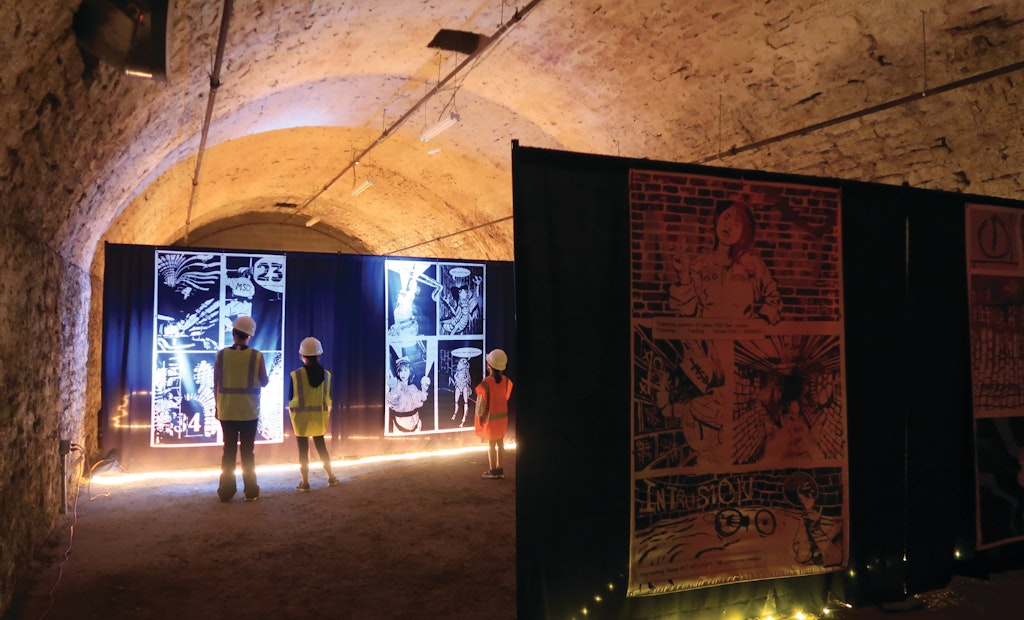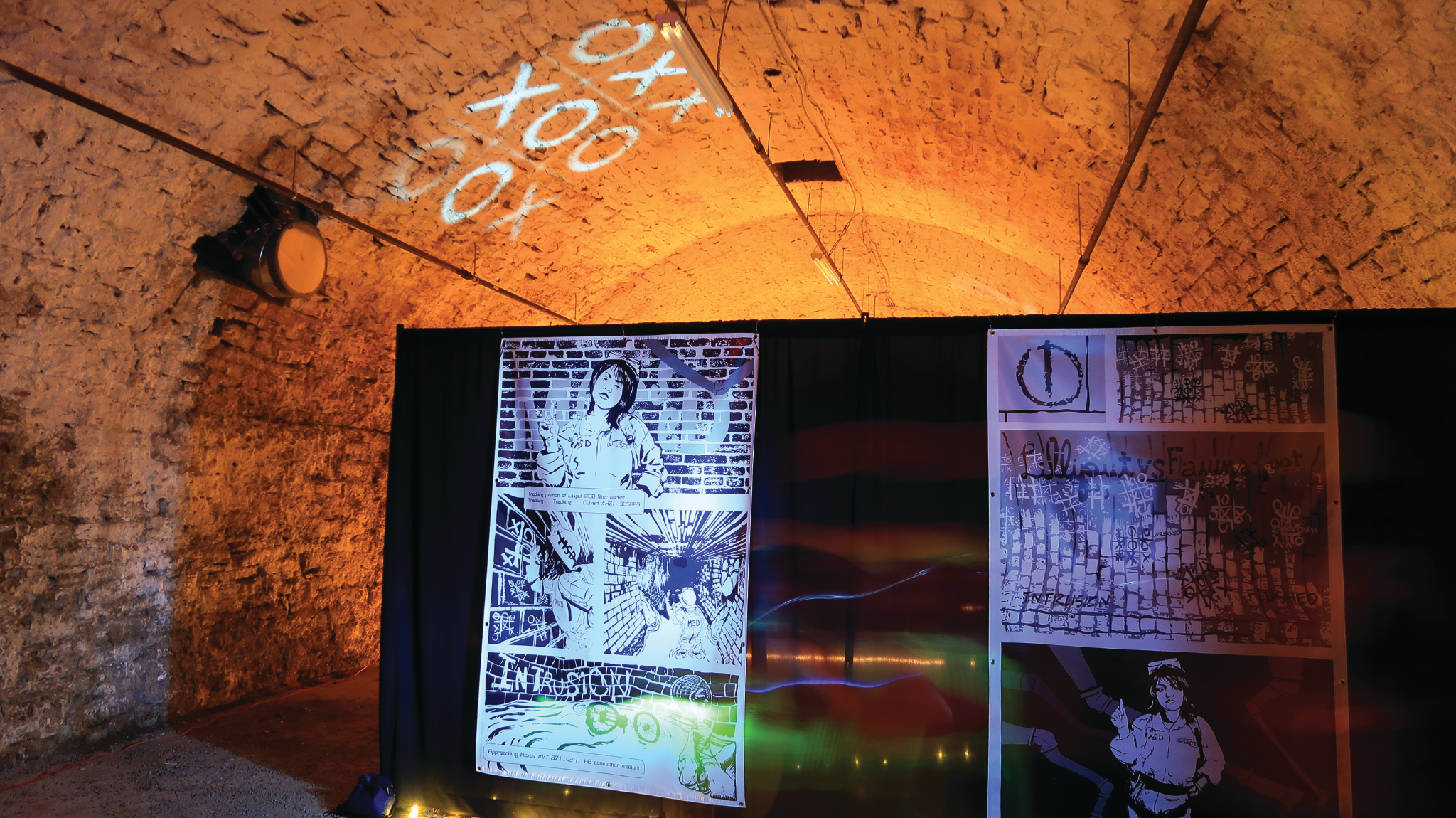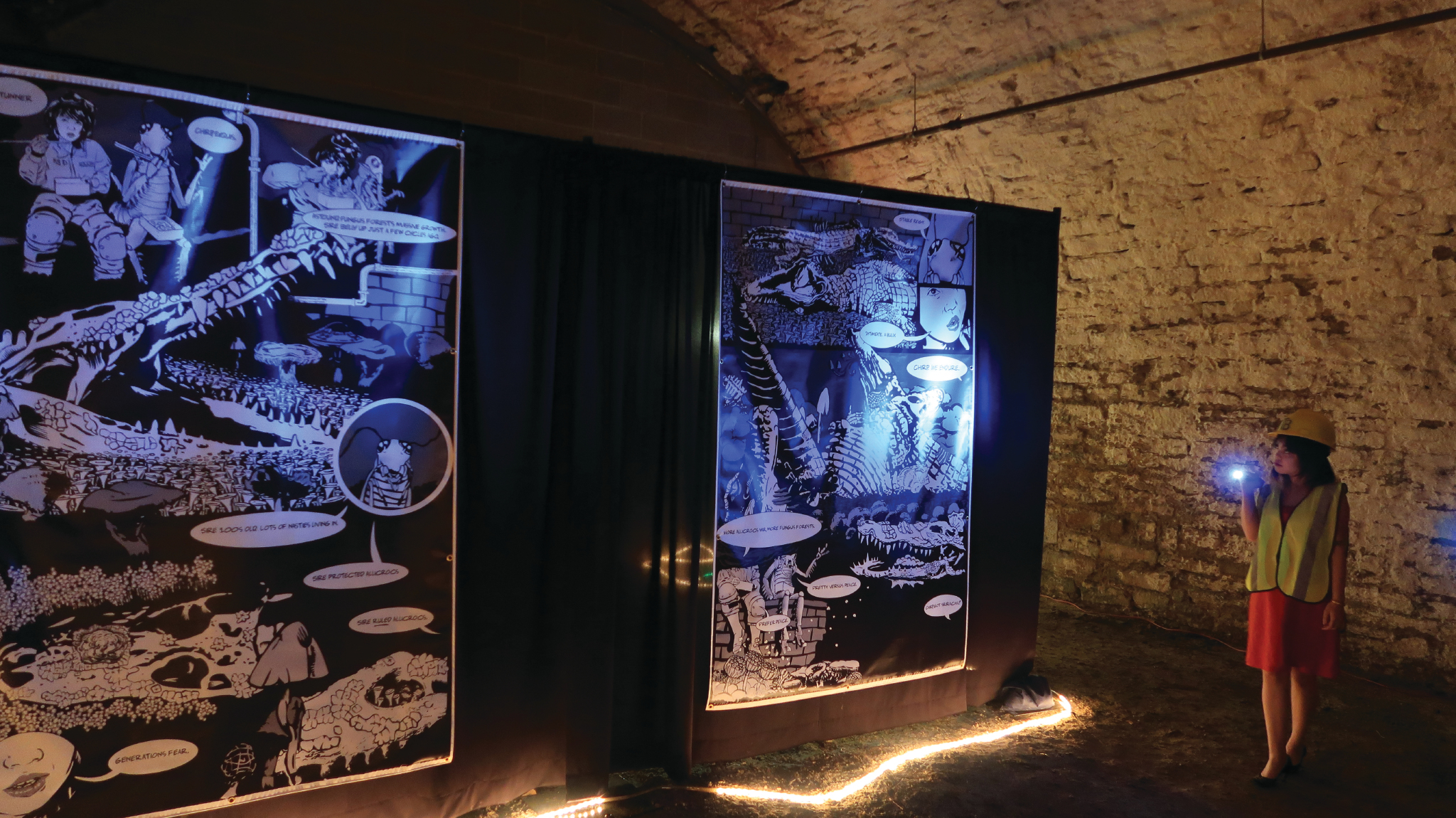
As part of his comic book project on municipal sewer systems, Cincinnati artist Jay Kalagayan and his team set up an art installation displaying the comics in a subterranean basement of Cincinnati’s Union Hall.
Interested in Education/Training?
Get Education/Training articles, news and videos right in your inbox! Sign up now.
Education/Training + Get AlertsYou’re walking down a dark tunnel with nothing but a flashlight beam for company. As the light bounces off walls dripping slime and flashes across murky liquid rushing below, you move forward with no way to know what lurks in the dark around each bend.
It may sound like fiction, but for sewer workers everywhere, it’s a daily reality. Unbeknownst to much of the public, there are many fantastical elements to sewer work. From fatbergs to treatment-resistance viruses, Cincinnati artist Jay Kalagayan is bringing those elements to life, giving the public a glimpse into the “weird, wet, wild world beneath our feet.”
Unexpected education
“I try to marry the science with the science fiction,” Kalagayan says of MeSseD Comics. The comic book is based on and takes place in a sewer system, featuring a tough and fearless sewer worker as its main character.
“I’m just amazed by the dedicated men and women who do this job; they do it well, and there’s no fanfare,” Kalagayan says. “It’s about how we’re a very ‘flush and forget it’ society. We don’t care about the system as long as it works, but we have no idea all that goes into it.”
The comic book takes sewer work and amps up the fantasy, turning common tubifex worms and wastewater filaments into larger-than-life monsters attacking the system and the story’s hero, Lilliput.
Though it is a stretch beyond reality, Kalagayan went to great lengths incorporating real obstacles that sewer workers run into on a daily basis.
It’s not explicitly set in any one city or municipal utility system, but MeSseD comes from the colloquial nickname used by Cincinnati’s Metropolitan Sewer District.
“I did research with MSD — tours of the treatment plant, I followed their trouble call crew for a day — and it was eye-opening. The amount of technology, the amount of intelligence and the amount of systems in place to treat our wastewater,” Kalagayan says. “The whole thing — the whole science of it — inspired me with the idea of MeSseD.
“What’s wonderful is when different people working for sewer utilities come up and compliment us on the book. They’re surprised anyone would even think it’s worthy of a comic book, but they’re happy it exists, that it’s out there, and it’s educating.”
One fan of the comic is Andrew Beardsley, an Ohio sewer worker who has volunteered his free time to collaborate with Kalagayan. “We were flabbergasted that somebody made a comic book about the sewer system, of all things,” he says. “It’s kind of nice to bring the sewers and some of the big, gross things that people don’t realize are down there out into the public.”
After finding the comic book by chance, he met with Kalagayan and started sending reference photos of sewer oddities that most people don’t see. He became a technical advisor to the team and helped with the second part of Kalagayan’s project: the tunnel tours.
An immersive experience
What could be better than a comic book featuring a municipal sewer? Try reading said comic in an atmosphere reminiscent of the sewer itself — an atmosphere that provides the feeling of being in a sewer while learning through an entertaining medium.
As part of the project, Kalagayan and his team set up an art installation displaying the comics in a subterranean basement of Cincinnati’s Union Hall.
“The fact that you’re reading a comic book that takes place underground, while you’re underground, I think adds to the experience of reading it,” Kalagayan says. “I wanted to do two things with this project. I wanted to change the way people experience comic books. It’s a very solitary act, and I wanted to make it more of a social act. Then I wanted to build awareness of the essential service that is provided by our sewer utilities.”
Exhibiting the first two seasons of MeSseD, the tour ends in an education room. That’s where Beardsley comes in. Using educational materials, he gives tourgoers context behind the comic, informing and answering questions on real-world applications.
“I want people to realize there’s a lot that goes into maintaining sewers. That’s why people pay so much money to do it,” Beardsley says. “I try to explain how old the sewer system in the city is. In some places, it’s 120 years old, so it takes a lot of manpower, and a lot of money to maintain and get it up to date.”
Questions from attendees have been encouraging. Other than "what’s the weirdest thing workers find in the sewer" (a cotton candy machine and bowling ball at the same time, in his case) they also ask what civilians can do to help the system.
Both Beardsley and Kalagayan were surprised by how many citizens fail to realize the effect of things like flushable wipes and grease on a sewer system.
“It’s invaluable. Anybody who picks up the book and enjoys it, I mean it’s a bed of information,” Beardsley says. “It was a fluke chance that we got ahold of him and this whole thing started. I just love the fact that it’s something nobody would expect, and people are truly embracing it — really enjoying reading it and doing the tunnel tour. It’s all coming together really well.”
To other sewer workers, he encourages involvement in projects like this.
“Don’t assume that people don’t care, because people are genuinely interested — not necessarily even just the comic book part of it, they’re interested in what’s going on with the sewer,” he says. “The best way is to get a lot of information out to a lot of people. I know it’s not the easiest thing to do, but give people a little more insight into what actually goes on, not the blanket statements that a lot of our utility companies give out. We need to get in-depth and explain things to people. They will have a little bit more empathy and sympathy for the people that do those jobs.”







